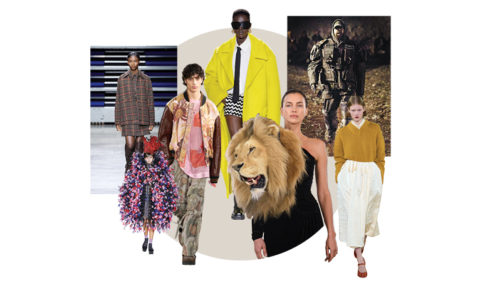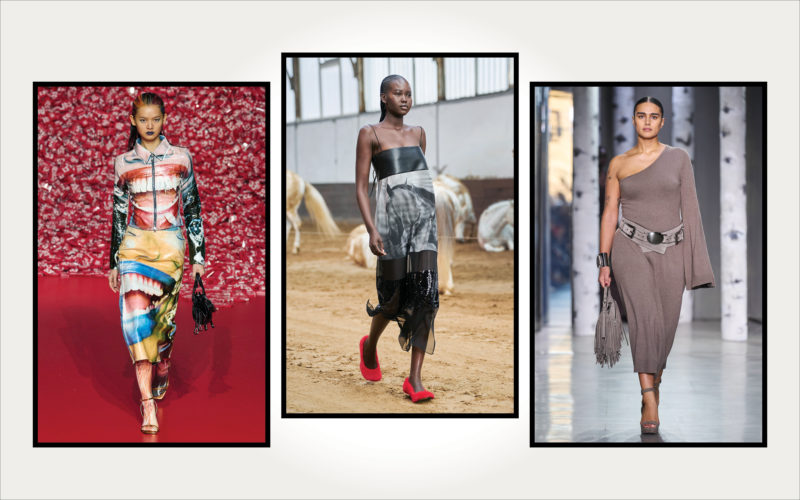After decades of deciphering designer looks, ‘FASHION’ editor-in-chief Bernadette Morra shares her tips on how to make sense of what comes down the catwalk.
“I don’t really understand how fashion shows work,” White Lotus actor Haley Lu Richardson told a New York Times reporter at the Diesel show in Milan in February. It’s not surprising that Richardson, who plays Portia in season two of the hit show, was a bit confounded. Even an industry vet like myself can be perplexed by what a designer puts forth on the runway. What, for example, were we to make of Schiaparelli’s lion’s-head dress for the Spring 2023 couture collection? Was it a publicity stunt or a way to remind us of the house’s Surrealist roots? Or was artistic director Daniel Roseberry actually hoping it would be purchased and worn? Read on to see what I keep in mind when viewing a runway show.
RELATED: Julia Fox Is a Campy Bride + Other Standout Moments From NYFW

Consider who is in charge
Goals vary among the people who are setting the agenda at a fashion label. Some are conceptualists (Iris van Herpen, Yohji Yamamoto, Kei Ninomiya at Noir) who strive to create something that has never been seen before. Their “clothes” — if you can call them that — can sometimes look like moving sculptures, which pretty much is, in fact, what they are. These are the sorts of shows that often elicit comments such as “Who is going to wear that?” But that’s missing the point of the exercise. These designers aren’t working to solve a problem like “What should I wear to the office this fall?” They are meeting a creative challenge that they have set for themselves. These visionaries will often have lucrative commercial ventures, like fragrances (Viktor & Rolf), that support their businesses. Cases in point: Rei Kawakubo’s successful T-shirt line collab with Nike and the now iconic sneaker collab with Converse, both under the label Comme des Garçons Play.
This is very different from people like Emilia Wickstead and Tanya Taylor, who deliver more-familiar wares in updated shapes and new fabrics and prints. They, too, are designers, but their end game is to solve a problem like “What should I wear to my niece’s wedding?” Or, as in the case of Max Mara and Alberta Ferretti, they simply want to entice us with something beautiful and luxurious that we can’t resist.
Most designers fall somewhere between these two extremes. They offer originality and relatability. Think Dries Van Noten, Miuccia Prada, Pierpaolo Piccioli at Valentino, Maria Grazia Chiuri at Dior, Sarah Burton at Alexander McQueen, Anthony Vaccarello at Saint Laurent and Lazaro Hernandez and Jack McCollough at Proenza Schouler.
Assess the environment
Often, there are clues about a designer’s intent in the show’s set design and music. Classical music playing in a gilded ballroom sets a very different tone than models walking through a field in silence. Many designers today commission art installations to create a unique setting that can become a major social media moment. Bonus: The looks are immediately identifiable on social media. There’s no way Stella McCartney’s wild horses darting around an equestrian arena can be confused with Akris’s industrial backdrop — even though both designers did lots of checked suits for Fall 2023. Sometimes, though, the atmosphere can overshadow the clothes. Does anyone remember anything from Balenciaga’s Spring 2023 presentation other than Ye marching through the mud?
Don’t judge a designer by their first show for a brand
When a designer jumps into a new role, it takes a while for them to find their way. They need to learn how to work with a production team, and that production team needs to learn how to work with them. Some designers create by draping cloth on the body, while others hand over sketches that need to be interpreted. Everyone needs to learn how to work together to ensure that what’s in the designer’s head can be executed as intended. And that takes time.
Where is the show taking place?
Historical context matters, and a show’s location can be a major indicator as to how you should frame what you see. New York’s Seventh Avenue was a manufacturing hub as far back as the early 20th century, so designers in that city tend to be more business-minded (Michael Kors, Tory Burch). London, England, which gave us the ’60s micro mini and ’70s punk, has always challenged the status quo and has an element of eccentricity that is pretty much expected (Vivienne Westwood, Christopher Kane, JW Anderson). Milan’s fashion industry grew from the fabric mills of Northern Italy, so there’s a big emphasis on materials (Fendi, Bottega Veneta, Missoni). And Paris fashion is rooted in haute couture, which grew out of the imperial court, cementing its position as the epicentre of luxury and craft at the highest level. This, in turn, draws creators from around the world, but only those deemed worthy in terms of technique and originality are given a slot on the official calendar.
There are exceptions, of course. The experimental sisters behind Rodarte mostly show their avant-garde looks in New York, while in Paris, Virginie Viard tends to stick to the tried-and-true at Chanel. And some designers switch fashion capitals now and then or stage off-calendar destination shows elsewhere around the globe. But you can pretty much assume that the closer you are to the Eiffel Tower, the more likely it is that what you will see on the runway is art.
Is it fashion or clickbait?
This is a hard question to answer. Some runway items are just too expensive to make and will only be used for an ad campaign or window display. Still, these are valuable marketing tools that are worth their weight in gold. According to Women’s Wear Daily, in the 48 hours following Coperni presenting its spray-on dress in Paris, the event’s media impact value was measured at $36.3 million, with nearly 80 per cent attributed to social media. However, the dress was never produced beyond the runway version.
And sometimes it’s not about the clothes at all
As compelling as the looks at Gucci and Hermès are, do they matter? Probably not, because in the end, a large portion of those houses’ revenue comes from bags and leather goods. But that shouldn’t stop us from enjoying their shows.
This article first appeared in FASHION’s October 2023 issue. Find out more here.
